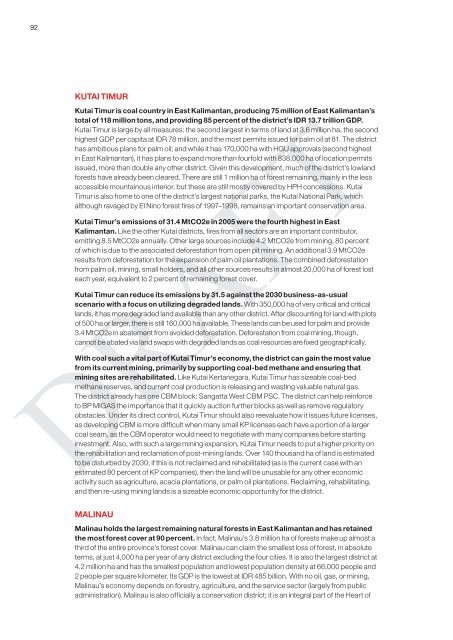East Kalimantan Environmentally Sustainable Development Strategy
East Kalimantan Environmentally Sustainable Development Strategy
East Kalimantan Environmentally Sustainable Development Strategy
Create successful ePaper yourself
Turn your PDF publications into a flip-book with our unique Google optimized e-Paper software.
92<br />
KUTAI TIMUR<br />
Kutai Timur is coal country in <strong>East</strong> <strong>Kalimantan</strong>, producing 75 million of <strong>East</strong> <strong>Kalimantan</strong>’s<br />
total of 118 million tons, and providing 85 percent of the district’s IDR 13.7 trillion GDP.<br />
Kutai Timur is large by all measures: the second largest in terms of land at 3.6 million ha, the second<br />
highest GDP per capita at IDR 78 million, and the most permits issued for palm oil at 81. The district<br />
has ambitious plans for palm oil; and while it has 170,000 ha with HGU approvals (second highest<br />
in <strong>East</strong> <strong>Kalimantan</strong>), it has plans to expand more than fourfold with 838,000 ha of location permits<br />
issued, more than double any other district. Given this development, much of the district’s lowland<br />
forests have already been cleared. There are still 1 million ha of forest remaining, mainly in the less<br />
accessible mountainous interior, but these are still mostly covered by HPH concessions. Kutai<br />
Timur is also home to one of the district’s largest national parks, the Kutai National Park, which<br />
although ravaged by El Nino forest fires of 1997–1998, remains an important conservation area.<br />
Kutai Timur’s emissions of 31.4 MtCO2e in 2005 were the fourth highest in <strong>East</strong><br />
<strong>Kalimantan</strong>. Like the other Kutai districts, fires from all sectors are an important contributor,<br />
emitting 8.5 MtCO2e annually. Other large sources include 4.2 MtCO2e from mining, 80 percent<br />
of which is due to the associated deforestation from open pit mining. An additional 3.9 MtCO2e<br />
results from deforestation for the expansion of palm oil plantations. The combined deforestation<br />
from palm oil, mining, small holders, and all other sources results in almost 20,000 ha of forest lost<br />
each year, equivalent to 2 percent of remaining forest cover.<br />
Kutai Timur can reduce its emissions by 31.5 against the 2030 business-as-usual<br />
scenario with a focus on utilizing degraded lands. With 350,000 ha of very critical and critical<br />
lands, it has more degraded land available than any other district. After discounting for land with plots<br />
of 500 ha or larger, there is still 160,000 ha available. These lands can be used for palm and provide<br />
3.4 MtCO2e in abatement from avoided deforestation. Deforestation from coal mining, though,<br />
cannot be abated via land swaps with degraded lands as coal resources are fixed geographically.<br />
With coal such a vital part of Kutai Timur’s economy, the district can gain the most value<br />
from its current mining, primarily by supporting coal-bed methane and ensuring that<br />
mining sites are rehabilitated. Like Kutai Kertanegara, Kutai Timur has sizeable coal-bed<br />
methane reserves, and current coal production is releasing and wasting valuable natural gas.<br />
The district already has one CBM block: Sangatta West CBM PSC. The district can help reinforce<br />
to BP MIGAS the importance that it quickly auction further blocks as well as remove regulatory<br />
obstacles. Under its direct control, Kutai Timur should also reevaluate how it issues future licenses,<br />
as developing CBM is more difficult when many small KP licenses each have a portion of a larger<br />
coal seam, as the CBM operator would need to negotiate with many companies before starting<br />
investment. Also, with such a large mining expansion, Kutai Timur needs to put a higher priority on<br />
the rehabilitation and reclamation of post-mining lands. Over 140 thousand ha of land is estimated<br />
to be disturbed by 2030; if this is not reclaimed and rehabilitated (as is the current case with an<br />
estimated 80 percent of KP companies), then the land will be unusable for any other economic<br />
activity such as agriculture, acacia plantations, or palm oil plantations. Reclaiming, rehabilitating,<br />
and then re-using mining lands is a sizeable economic opportunity for the district.<br />
DRAFT<br />
MALINAU<br />
Malinau holds the largest remaining natural forests in <strong>East</strong> <strong>Kalimantan</strong> and has retained<br />
the most forest cover at 90 percent. In fact, Malinau’s 3.8 million ha of forests make up almost a<br />
third of the entire province’s forest cover. Malinau can claim the smallest loss of forest, in absolute<br />
terms, at just 4,000 ha per year of any district excluding the four cities. It is also the largest district at<br />
4.2 million ha and has the smallest population and lowest population density at 66,000 people and<br />
2 people per square kilometer. Its GDP is the lowest at IDR 485 billion. With no oil, gas, or mining,<br />
Malinau’s economy depends on forestry, agriculture, and the service sector (largely from public<br />
administration). Malinau is also officially a conservation district; it is an integral part of the Heart of

















